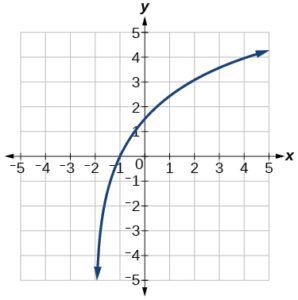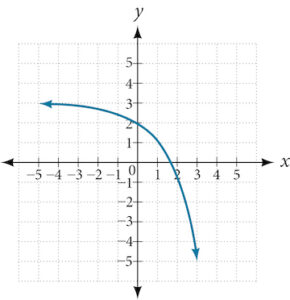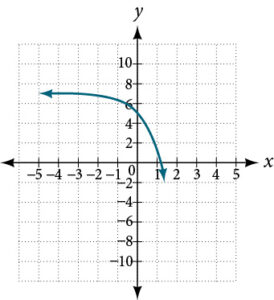Exponential Functions
For the following exercises, identify whether the statement represents an exponential function. Explain.
- A population of bacteria decreases by a factor of [latex]\dfrac{1}{8}[/latex] every [latex]24[/latex] hours.
- For each training session, a personal trainer charges his clients [latex]$5[/latex] less than the previous training session.
For the following exercises, consider this scenario: For each year [latex]t[/latex], the population of a forest of trees is represented by the function [latex]A(t) = 115(1.025)^t[/latex]. In a neighboring forest, the population of the same type of tree is represented by the function [latex]B(t) = 82(1.029)^t[/latex]. (Round answers to the nearest whole number.)
- Which forest’s population is growing at a faster rate?
- Assuming the population growth models continue to represent the growth of the forests, which forest will have a greater number of trees after [latex]20[/latex] years? By how many?
For the following exercises, determine whether the equation represents exponential growth, exponential decay, or neither. Explain.
- [latex]y = 220(1.06)^x[/latex]
- [latex]y = 11,701(0.97)^t[/latex]
For the following exercises, find the formula for an exponential function that passes through the two points given.
- [latex](0, 2000)[/latex] and [latex](2, 20)[/latex]
- [latex]\left(-1, \dfrac{3}{2}\right)[/latex] and [latex](3, 24)[/latex]
For the following exercises, determine whether the table could represent a function that is linear, exponential, or neither. If it appears to be exponential, find a function that passes through the points.
-
[latex]x[/latex] [latex]1[/latex] [latex]2[/latex] [latex]3[/latex] [latex]4[/latex] [latex]f(x)[/latex] [latex]70[/latex] [latex]40[/latex] [latex]10[/latex] [latex]-20[/latex] -
[latex]x[/latex] [latex]1[/latex] [latex]2[/latex] [latex]3[/latex] [latex]4[/latex] [latex]m(x)[/latex] [latex]80[/latex] [latex]61[/latex] [latex]42.9[/latex] [latex]25.61[/latex] -
[latex]x[/latex] [latex]1[/latex] [latex]2[/latex] [latex]3[/latex] [latex]4[/latex] [latex]g(x)[/latex] [latex]-3.25[/latex] [latex]2[/latex] [latex]7.25[/latex] [latex]12.5[/latex]
For the following exercises, evaluate each function. Round answers to four decimal places, if necessary.
- [latex]f(x) = -4^{2x+3}[/latex], for [latex]f(-1)[/latex]
- [latex]f(x) = -2e^{x-1}[/latex], for [latex]f(-1)[/latex]
- [latex]f(x) = 1.2e^{2x} - 0.3[/latex], for [latex]f(3)[/latex]
For the following exercises, determine the equation of the new function, [latex]g(x)[/latex]. State its [latex]y[/latex]-intercept, domain, and range.
- [latex]f(x) = 3^x[/latex] is reflected about the [latex]y[/latex]-axis and stretched vertically by a factor of [latex]4[/latex]. What is the equation of the new function, [latex]g(x)[/latex]?
- [latex]f(x) = 10^x[/latex] is reflected about the [latex]x[/latex]-axis and shifted upward [latex]7[/latex] units. What is the equation of the new function, [latex]g(x)[/latex]?
- [latex]f(x) = -\dfrac{1}{2}\left(\dfrac{1}{4}\right)^{x-2} + 4[/latex] is shifted downward [latex]4[/latex] units, then shifted left [latex]2[/latex] units, stretched vertically by a factor of [latex]4[/latex], and reflected about the [latex]x[/latex]-axis. What is the equation of the new function, [latex]g(x)[/latex]?
For the following exercise, graph the function and its reflection about the [latex]y[/latex]-axis on the same axes, and give the [latex]y[/latex]-intercept.
- [latex]g(x) = -2(0.25)^x[/latex]
For the following exercise, graph each set of functions on the same axes.
- [latex]f(x) = 3\left(\dfrac{1}{4}\right)^x[/latex], [latex]g(x) = 3(2)^x[/latex], and [latex]h(x) = 3(4)^x[/latex]
For the following exercises, match each function with one of the graphs in the figure below.
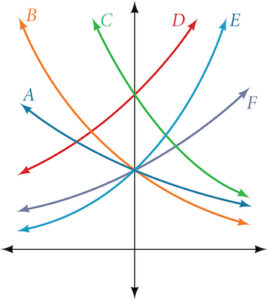
- [latex]f(x) = 2(0.69)^x[/latex]
- [latex]f(x) = 2(0.81)^x[/latex]
- [latex]f(x) = 2(1.59)^x[/latex]
For the following exercises, use the graphs shown in the figure below. All have the form [latex]f(x) = ab^x[/latex].
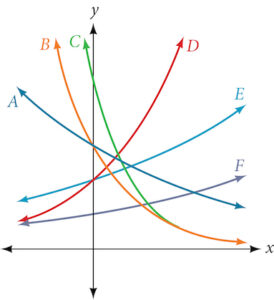
- Which graph has the largest value for [latex]b[/latex]?
- Which graph has the largest value for [latex]a[/latex]?
For the following exercises, start with the graph of [latex]f(x) = 4^x[/latex]. Then write a function that results from the given transformation.
- Shift [latex]f(x)[/latex] 3 units downward
- Shift [latex]f(x)[/latex] 5 units right
- Reflect [latex]f(x)[/latex] about the [latex]y[/latex]-axis
For the following exercise, each graph is a transformation of [latex]y=2^x[/latex]. Write an equation describing the transformation.
For the following exercise, find an exponential equation for the graph.
Applications of Exponential Functions
For the following exercises, use the compound interest formula, [latex]A(t) = P\left(1 + \dfrac{r}{n}\right)^{nt}[/latex]. After a certain number of years, the value of an investment account is represented by the equation [latex]A = 10,250(1 + \dfrac{0.04}{12})^{120}[/latex].
- What was the initial deposit made to the account?
- An account is opened with an initial deposit of [latex]$6,500[/latex] and earns [latex]3.6\%[/latex] interest compounded semi-annually. What will the account be worth in [latex]20[/latex] years?
- Solve the compound interest formula for the principal, [latex]P[/latex].
- How much more would the account in the previous two exercises be worth if it were earning interest for [latex]5[/latex] more years?
- Use the formula found in the previous exercise to calculate the interest rate for an account that was compounded semi-annually, had an initial deposit of [latex]$9,000[/latex] and was worth [latex]$13,373.53[/latex] after [latex]10[/latex] years.
For the following exercises, determine whether the equation represents continuous growth, continuous decay, or neither. Explain.
- [latex]y = 3742(e)^{0.75t}[/latex]
- [latex]y = 2.25(e)^{-2t}[/latex]
- The fox population in a certain region has an annual growth rate of [latex]9\%[/latex] per year. In the year [latex]2012[/latex], there were [latex]23,900[/latex] fox counted in the area. What is the fox population predicted to be in the year [latex]2020[/latex]?
- In the year [latex]1985[/latex], a house was valued at [latex]$110,000[/latex]. By the year [latex]2005[/latex], the value had appreciated to [latex]$145,000[/latex]. What was the annual growth rate between [latex]1985[/latex] and [latex]2005[/latex]? Assume that the value continued to grow by the same percentage. What was the value of the house in the year [latex]2010[/latex]?
- Jaylen wants to save [latex]$54,000[/latex] for a down payment on a home. How much will he need to invest in an account with [latex]8.2\%[/latex] APR, compounding daily, in order to reach his goal in [latex]5[/latex] years?
- Alyssa opened a retirement account with [latex]7.25\%[/latex] APR in the year [latex]2000[/latex]. Her initial deposit was [latex]$13,500[/latex]. How much will the account be worth in [latex]2025[/latex] if interest compounds monthly? How much more would she make if interest compounded continuously?
Logarithmic Functions
For the following exercises, rewrite each equation in exponential form.
- [latex]\log_a(b) = c[/latex]
- [latex]\log_x(64) = y[/latex]
- [latex]\log_{15}(a) = b[/latex]
For the following exercises, rewrite each equation in logarithmic form.
- [latex]c^d = k[/latex]
- [latex]19^x = y[/latex]
- [latex]y^x = \dfrac{39}{100}[/latex]
For the following exercises, solve for [latex]x[/latex] by converting the logarithmic equation to exponential form.
- [latex]\log_2(x) = -3[/latex]
- [latex]\log_3(x) = 3[/latex]
- [latex]\log_9(x) = \dfrac{1}{2}[/latex]
For the following exercises, use the definition of common and natural logarithms to simplify.
- [latex]10^{\log(32)}[/latex]
- [latex]e^{\ln(1.06)}[/latex]
- [latex]e^{\ln(10.125)} + 4[/latex]
For the following exercises, evaluate the base [latex]b[/latex] logarithmic expression without using a calculator.
- [latex]\log_6(\sqrt{6})[/latex]
- [latex]6\log_8(4)[/latex]
For the following exercises, evaluate the common logarithmic expression without using a calculator.
- [latex]\log(0.001)[/latex]
- [latex]2\log(100^{-3})[/latex]
For the following exercises, evaluate the natural logarithmic expression without using a calculator.
- [latex]\ln(1)[/latex]
- [latex]25\ln\left(e^{\frac{2}{5}}\right)[/latex]
Logarithmic Function Graphs and Characteristics
For the following exercises, state the domain and range of the function.
- [latex]h(x) = \ln\left(\dfrac{1}{2} - x\right)[/latex]
- [latex]h(x) = \ln(4x + 17) - 5[/latex]
For the following exercises, state the domain and the vertical asymptote of the function.
- [latex]f(x) = \log_b(x - 5)[/latex]
- [latex]f(x) = \log(3x + 1)[/latex]
- [latex]g(x) = -\ln(3x + 9) - 7[/latex]
For the following exercises, state the domain, range, and [latex]x[/latex]– and [latex]y[/latex]-intercepts, if they exist. If they do not exist, write [latex]DNE[/latex].
- [latex]h(x) = \log_4(x - 1) + 1[/latex]
- [latex]g(x) = \ln(-x) - 2[/latex]
- [latex]h(x) = 3\ln(x) - 9[/latex]
For the following exercises, match each function in the figure below with the letter corresponding to its graph.
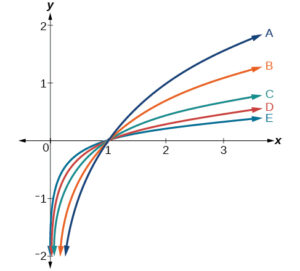
- [latex]f(x) = \ln(x)[/latex]
- [latex]h(x) = \log_5(x)[/latex]
For the following exercises, match each function in the figure below with the letter corresponding to its graph.
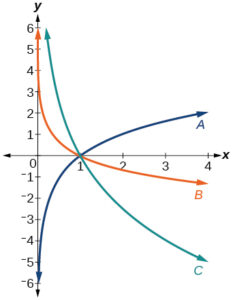
- [latex]f(x) = \log_{\frac{1}{3}}(x)[/latex]
- [latex]h(x) = \log_{\frac{3}{4}}(x)[/latex]
For the following exercises, sketch the graphs of each pair of functions on the same axis.
- [latex]f(x) = \log(x)[/latex] and [latex]g(x) = \log_{\frac{1}{2}}(x)[/latex]
- [latex]f(x) = e^x[/latex] and [latex]g(x) = \ln(x)[/latex]
For the following exercises, sketch the graph of the indicated function.
- [latex]f(x) = \log_2(x + 2)[/latex]
- [latex]f(x) = \ln(-x)[/latex]
- [latex]g(x) = \log(6 - 3x) + 1[/latex]
For the following exercises, write a logarithmic equation corresponding to the graph shown.
- Use [latex]y = \log_2(x)[/latex] as the parent function.
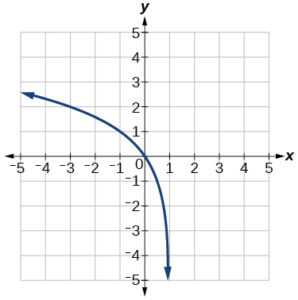
- Use [latex]f(x) = \log_4(x)[/latex] as the parent function.
